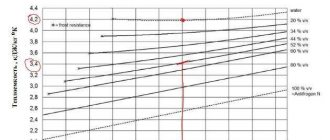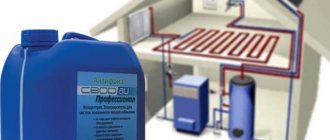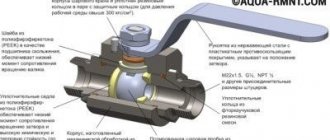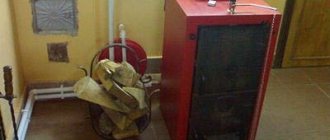How is antifreeze different from water?
If you live in a private house permanently, it is recommended to fill the heating system with distilled water. If there is a possibility that such a coolant will freeze, use antifreeze. One of the advantages of the product is that pipes and radiators do not need to be emptied, even if no one lives in the house in winter. When filling pipes with water, this will have to be done, since due to expansion due to crystallization, the pipeline may burst .
The disastrous consequences of a frozen pipe in a radiator
The main advantage of antifreeze compared to water is their low freezing point. As a rule, solutions used in private homes are designed to work at a lower temperature threshold of -65...-30 °C . For some products this threshold reaches -70 °C . But even if the temperatures are lower, the substance does not harden, but goes into a jelly-like state and is characterized by a lower expansion rate than water. After defrosting, the “anti-freeze” does not lose its performance properties. This deprives the home owner of worries that during severe frosts the pipes and boiler will be damaged, and with a subsequent increase in temperature the house will flood.
Another disadvantage of water is that it reacts with metals and causes their gradual destruction, or corrosion . During the heating process, scale , which settles on the inner walls of pipes, radiators, and other components.
Antifreezes usually contain special substances - additives that prevent the formation of lime deposits and help extend the life of metal surfaces. At the same time, the active substances used in the production of antifreeze are mostly quite aggressive substances. They are also capable of destroying heating system elements. To prevent this from happening, additives are included in the composition.

Scale in heating radiators when using hard water
Prices for popular models of heating radiators
Heating radiators
But antifreeze also has disadvantages compared to water:
- high viscosity , which requires the installation of more powerful pumping equipment;
- heat capacity is 15% lower , which affects heat transfer;
- the need for more thorough sealing of connections;
- excessive toxicity of some products;
- the need for disposal of substances , which can pose certain problems;
- formation of solid sediment , due to which the system becomes clogged, destroyed, and carbon deposits form in the boiler;
- high cost - 20-30 USD. e. for 20 l.
Table 1. Comparison of the properties of antifreeze and water.
| Options | Water, % | Antifreeze,% |
| Specific thermal conductivity indicators | 100 | Up to 90 |
| Density | From 110 | |
| Viscosity (t° 80°С) | From 130 | |
| Volume expansion | From 130 | |
| Fluidity | Up to 150 |
Therefore, experts advise using antifreeze only if people rarely live in a house with steam heating in winter.
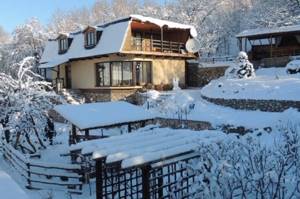
Antifreeze is used when there is a risk of heating system freezing
The cost of installing heating systems
Heating system installation
| Heating radiator installation | PC | from 2,000 ₽ |
| Installation of a floor-mounted convector | PC | from 4,500 ₽ |
| Installation of a heating radiator ( non-standard size, cast iron, design) | PC | from 4,500 ₽ |
| Installation of distribution heating cabinet | PC | 4 500 ₽ |
| A set of works for installing a heating system for a house up to 100 m² | from | 49 500 |
| A set of works for installing a heating system for a house up to 150 m² | from | 52 500 |
| A set of works for installing a heating system for a house up to 200 m² | from | 72 500 |
| A set of works for installing a heating system for a house up to 250 m² | from | 87 500 |
| Please call for exact cost | 84957446774 |
The cost of installing heating systems . Price adjusted as of May 05, 2021 Attention. This cost is a preliminary estimate; these prices should only be used as approximate prices. The exact cost of the work is calculated after an engineer visits the work site, its complexity, and quantity.
Installation of an underfloor heating system (warm floor)
| Water heated floor | m² | from 500 ₽ |
| Distribution manifold cabinet for underfloor heating (external) | PC | 4 500 ₽ |
| Heated floor temperature control device | PC | from 2 000 ₽ |
| Heated floor temperature control groups (thermostatic valve, thermostat with clamp-on sensor, bypass valve, starter) | PC | 3 750 ₽ |
| Main pipes heating system and pipe insulation (cross-linked polyethylene, metal-plastic) up to 20 mm | m/linear | 100 ₽ |
| Main pipes heating system and insulation with pipe insulation (cross-linked polyethylene, metal-plastic) up to 32 mm | m/linear | 230 ₽ |
| The exact cost is calculated after check-out | engineer |
The cost of installing heating systems . Price adjusted as of May 05, 2021 Attention. This cost is a preliminary estimate; these prices should only be used as approximate prices. The exact cost of the work is calculated after an engineer visits the work site, its complexity, and quantity.
Installation of heating systems for warehouses, hangars, workshops, car service centers
| Installation of a fan heater , with pipes, fastening to a concrete wall | PC | from 15 000 ₽ |
| Installation of automatic fan heater control | PC | from 4 500 ₽ |
| Pressure testing, commissioning, filling with coolant | m2 | from 100 ₽ |
| Register mounting, thread | PC | from 6 750 ₽ |
| Register installation, welding | PC | from 15 000 ₽ |
| The exact cost is calculated after check-out | _engineer_ |
The cost of installing heating systems . Price adjusted as of May 05, 2021 Attention. This cost is a preliminary estimate; these prices should only be used as approximate prices.
The exact cost of the work is calculated after an engineer visits the work site, its complexity, and quantity. Heating cost calculation
The cost of repairing heating systems
Cost of installation of water supply
Similar services:
Replacing the coolant in dacha heating Creating a warm, safe atmosphere in a summer country house has its own characteristics. Often, owners come here for a short time, and when leaving, they turn off the devices. For this reason, there is a possibility of freezing and further damage to communications. Particular attention must be paid to preparing the heating system for...
Replacement of heating boilers in private homes A specialized company replaces heating boilers and re-equips boiler rooms in private homes and furnace enterprises in (New) Moscow and the Moscow region. A package of necessary documents for the gas industry trust after changing gas equipment. Installation of heating equipment in a private home is done on a turnkey basis…
Installation of a heating system in a country house Previously, most country houses were tightly closed for the winter at the end of the season. And the Soviet proverb that one move is equal to two repairs perfectly illustrated the average family’s departure to the dacha in the spring. Old wood stoves, potbelly stoves, electric heaters, because of which...
Replacement of coolant from 18,000 ₽ Draining the heating system Blowing with a compressor from residual liquid Filling with new coolant Removing air Start-up and adjustment work of the heating system Disposal of old coolant For details, call 8 495 744 67 74 Please note, you may need to ► flush the heating system with chemicals Specialists…
Heating and boiler room Heating of the house must be thought through before the construction of the house itself begins. Especially if this house is not just a light home for a summer resident, which he uses only in the warm season, but a full-fledged residential building, where people should live comfortably in the most…
Diesel heating of a private house Heating of a house Installation of a diesel heating boiler, installation of diesel heating for a private country house Diesel heating of a private house Diesel heating of a house is an inherently expensive undertaking, but at the same time in some regions of Russia there is simply no alternative. It's connected with…
Heating a house 100m As you know, the most important thing in your own private home is warmth, comfort, convenience and coziness. It is necessary for all family members to be comfortable at any time of the year, and not have to dress warmly in woolen clothes and wrap themselves in a blanket in the evenings...
Underfloor heating Heated floors are the most comfortable way for a person to maintain room temperature. This is especially true if there are children in the house. Warm floors pay for their cost Electric heated floors have long been used in apartments, in individual houses where there are autonomous boiler rooms,…
Gas heating of a country house In a warm house, you can always shelter from cold and bad weather, even if it is a country house. After all, now you can easily install a heating system in it. Especially among the owners of such houses, gas heating is in demand. With its unrivaled performance and ease of use,…
Water heating at home - Boiler room Water heating at home Most of us are accustomed to comfort and one of the conditions for ensuring it is......
Heating a private house - boiler room Heating a private house for Russia is one of the most important topics when starting construction. But despite its importance, many consider it too simple a task to think about designing. In fact, even a system assembled without a design or calculations...
Electric heating of a cottage Regardless of the fact that electric systems are the cheapest, in reality they are considered the most unprofitable in economic terms. Here……
Heating a private house with water heated floors Today, heated floor technology is not much inferior in efficiency to radiator heating systems, but it has a lot of advantages. We propose to consider the main advantages of hidden heating systems, installation and connection features...
Heating a house with warm floors Warm floors under your feet instead of ice tiles - who among us doesn’t dream of this in winter? Fortunately, this dream is 100% feasible: in modernly renovated apartments, electrical systems are increasingly being installed, which, if the correct model is selected, can...
Radiator autonomous heating RADIATOR HEATING Do you have to solve the problem of space heating? Efficient, convenient, economical......
Heating a wooden house Thanks to the availability of materials, wooden houses have always been one of the most popular in Russia. Today, with the development of modern technologies, quite a lot of competing materials have appeared, but wood is still in demand. Each material has different thermal conductivity characteristics and requires individual calculation of the heating system. Let's consider...
Heating a private country house Modern individual heating systems Currently, several heating systems are used: stove, gas, electric, steam. Steam is used mainly as central heating for apartment buildings. To implement this type of heating, it is necessary to create communications isolated from the surrounding conditions, build a workshop or...
Warm floor - floor heating with plastic pipes Contents of the article: Floor laying specialists and repairmen have long been ordered to install floor heating in private homes. It's so nice to walk on a warm floor in winter. And if you consider that it is also economical, then many will be interested in such heating. This kind of floor...
Heating a house without a pump Having decided to build a private house, every owner must carefully consider heating, since you will not be able to live through the winter without it. In cities everything is much simpler. The heating system was originally designed and cannot be changed. In a country house, all design issues...
Types of antifreeze for heating
Depending on the substance that forms the base, there are three types of antifreeze:
- ethylene glycol;
- propylene glycol;
- glycerin.
Ethylene glycol products
The main disadvantage of these substances is their high toxicity when inhaled or in contact with the skin. Because of this, they cannot be used in double-circuit networks, when the coolant can enter the hot water circuit. To reduce the risk and warn the buyer of the high level of danger, such products are colored red . This allows leaks to be detected early. Antifreezes based on ethylene glycol work at temperatures down to -65 ° C.
Reference! In some developed countries, the production of anti-freeze products based on ethylene glycol is prohibited.
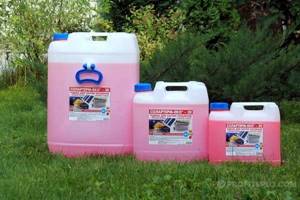
Ethylene glycol antifreeze is colored red to detect toxic leakage.
Prices for ethylene glycol antifreeze
Antifreeze for heating system BOILER
Propylene glycol products
This category of products does not have many of the disadvantages inherent in ethylene glycol-based analogues, the main one of which is toxicity. Propylene glycol antifreeze is a more progressive development , which has already gained popularity among owners of private houses, especially those that use an open heating system model, double-circuit boilers.
Interesting! One proof of the product's harmlessness is the use of varieties of propylene glycols as a food additive and ingredient in cosmetics . Therefore, if a substance leaks into water, the harm to health will be minimal.
Propylene glycols have the best thermal properties. In addition, they take care of the internal surface of the devices. This reduces hydraulic resistance and reduces energy losses.
One of the disadvantages of propylene glycol coolants is their high price . In addition, the developers were unable to “make friends” of the substance with zinc.
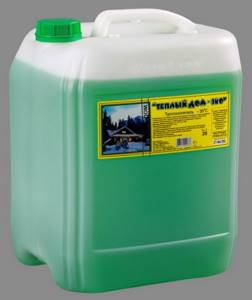
Propylene glycol products are safer and green in color
Prices for propylene glycol products
Antifreeze Warm Home – Eco
Glycerin products
Experts have an ambiguous attitude towards glycerin-based products. Some believe that such antifreezes have almost no drawbacks. Others mercilessly criticize this category of coolants.
To summarize, the advantages of glycerin-based antifreeze also include:
- safety of the base substance in relation to the environment;
- lower temperature crystallization;
- lack of volumetric expansion during freezing;
- compatibility with galvanized surfaces, materials from which sealing parts are made, with some exceptions;
- does not require special cleaning or flushing of the system after draining;
- service life 7-10 years ;
- explosion and fire safety;
- high level of heat transfer;
- impressive operating temperature range - from -30 to 105 °C .
Glycerin antifreeze is cheaper than propylene glycol.
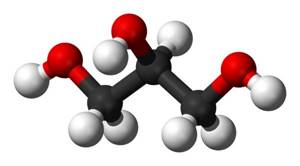
The attitude towards glycerin antifreeze is ambiguous
However, glycerin antifreeze also has disadvantages:
- the density of this product is higher than the previous two;
- rapid wear of heating equipment due to the high viscosity of the product;
- low heat capacity compared to propylene glycol-based products;
- thermal instability, at 90 ° C the product decomposes, forming the poison acrolein;
- high viscosity, which is why high-power pumps are needed (another solution to the problem is dilution with alcohol);
- tendency to foam, which contributes to airing of the heating system;
- interaction with components made of non-polar rubber and plastic;
- after evaporation of water, the shelf life is lost, the product takes a solid or jelly-like form even at a temperature of 15 °C .
Critics argue that glycerin antifreeze is not a new product on the market, but also a step into the past. As an argument, they cite the fact that such products were used before the 50s of the last century. However, then chemists developed other glycol-based products with better performance properties.
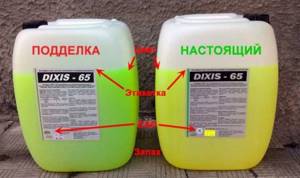
Glycerin is used to produce counterfeits of high-quality antifreeze
There are no clear standards for the production of glycerin antifreeze. Manufacturers create them based on specifications that they develop independently. In addition, glycerin is a common component of counterfeit coolants that are positioned as propylene glycol. The reason is the lower cost of raw materials.
Note! In some EU countries, glycerin antifreeze is not produced as it is ineffective.
Prices for glycerin antifreeze
Antifreeze DIXIS – 65
Video - Selecting a coolant for a heating system
What to consider when choosing antifreeze
When buying antifreeze, pay attention to the following indicators:
- temperature range at which the coolant performs its functions - the wider it is, the better;
- heat capacity, that is, the amount of coolant consumed to pump a unit of time to transfer the required amount of heat, while losses should be minimal;
- viscosity coefficient, on which the speed of its circulation, heat transfer, etc. depends;
- corrosive activity in relation to the materials of the elements from which the heating system is assembled;
- safety for nature and people;
- low viscosity - the higher the indicator, the lower the efficiency;
- inertness to foaming, on which the efficiency of the pump depends.
Attention! The composition should not contain substances that make polymers and other materials brittle and lead to their destruction.
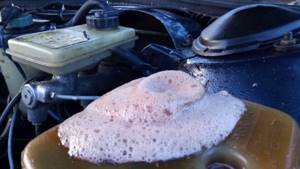
Inertness to foaming is one of the main quality indicators
Coolant selection options
- If you have a private house or apartment in which you permanently live (at least in winter you do not turn off the heating in them), the best option is to use technically prepared water as a coolant. That is, it should contain the concentrations of calcium, iron, manganese salts, as well as the amount of dissolved air, to the maximum permissible values. The best option for batteries is bimetallic radiators, which have high corrosion resistance to water.
- For houses with periodic use, it is necessary to use a PG solution. The required concentration will be selected by specialists in heating systems, based on possible temperature readings in the rooms when the heating is turned off.
- For non-residential objects, you can use EG solution.
It should be remembered that solutions of EG and PG have various additives to improve their properties. Therefore, in order to avoid the occurrence of insoluble precipitates, firstly, these solutions cannot be mixed. Secondly, even when using the same type of solution, it is best to use products from the same manufacturer. For example, when adding coolant. In any case, entrust the olive oil or fluid replacement to specialists.
Is it possible to use automotive antifreeze in heating networks?
Automotive antifreeze is prohibited for use in the heating system.
Products intended for cars contain substances that are harmful to human health - amines, phosphates, nitrites. These compounds are too aggressive on rubber and metal parts.
Another reason why automobile analogues are prohibited in heating systems is the ban on mixing with water. The service life of antifreeze is only 3 years.
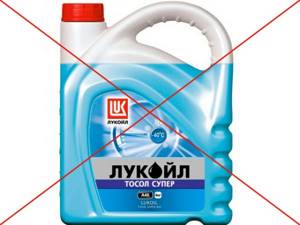
Car rulers are not suitable for pouring into heating pipes
Heating maintenance - replacing antifreeze
What is antifreeze replacement?
This change of water allows you to avoid defrosting the heating system as a whole during the winter season. In another way, changing water can be called introducing a substance into the heating equipment that is not capable of freezing.
| Monday | Open 24 hours |
| Tuesday | Open 24 hours |
| Wednesday | Open 24 hours |
| Thursday | Open 24 hours |
| Friday | Open 24 hours |
| Saturday | Open 24 hours Now open |
| Sunday | Open 24 hours |
Heating maintenance - replacing antifreeze
After the introduction of such a substance, the treated material must be replaced with an updated one. All these actions can only be carried out by an experienced specialist, because replacing heating material is a labor-intensive task that can be performed with dexterity, certain skills and professional training. Antifreezes are considered harmful substances containing toxins. Toxins require careful use because they can expand more than water.
Engineering communications service Heating, water supply, drainage, sewerage systems
around the clock tel: 8
INSTALLATION, REPAIR, MAINTENANCE, MODERNIZATION, REPLACEMENT
How to replace the coolant
- Draining the heating system If necessary, dispose of the coolant at our company's warehouse if another coolant was previously filled.
How to replace antifreeze in a home heating system - step-by-step instructions
Before draining the antifreeze, warm up the heating boiler, even if the replacement is carried out in the summer. All batteries are opened, the system is switched to gravity mode. Immediately before draining, turn off the boiler and disconnect other devices involved in the system from power sources. You should also prepare a sufficient amount of containers for used antifreeze.

Water or antifreeze? The choice is yours
Attention! Circulation pumps instantly fail if there is no coolant in the unit. To prevent this from happening, turn off the taps that disconnect the pumps from the entire system (they are located on the right and left or above and below the device). A minimal amount of old coolant will remain inside.
Then proceed in the following order:
Step 1. Insert the hose into the prepared container.
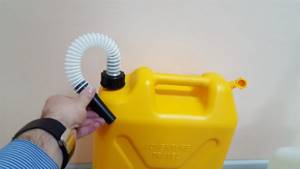
We prepare the hose and container for used antifreeze
Step 2. Open the drain valve.
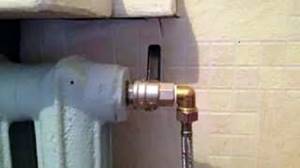
Let's start draining
Step 3. Fill the containers one by one.
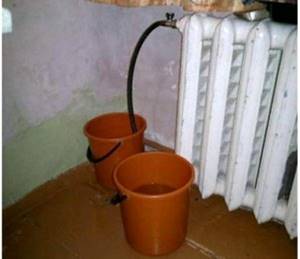
If there are no cans, you can use buckets
Step 4. If a tap is not provided for a particular riser, it is released from the coolant through the Mayevsky tap using an attached hose.
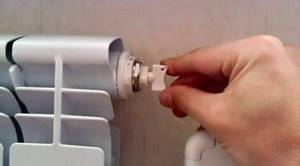
The Mayevsky tap can also be used as a drain hole
Step 5. Antifreeze is diluted in a large container according to the manufacturer's instructions.
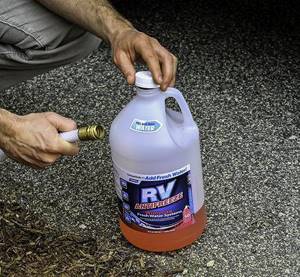
We dilute the antifreeze strictly according to the instructions
Step 6. Connect the “Baby” pump to the hole for injection into the heating system and fill the pipes with fresh coolant.

If there is no special pump, you can find a hand pump
Step 7. When filling the system, periodically bleed air, pumping in antifreeze until the required pressure in the system is achieved.

Monitoring blood pressure readings
Cost of replacing heating system coolant
| Cost of work, excluding the cost of materials, house up to 100 m² | Cost, rub |
| Draining the heating system | from 900 |
| Blowing out residual coolant with a compressor | from 1 200 |
| Easy rinsing with water | from 2 000 |
| Blowing out residues with a compressor | from 1 200 |
| Disposal of coolant | from 2 000 |
| Pressure testing of the heating system | from 2 000 |
| Filling with coolant | from 6 500 |
| Commissioning and commissioning of the heating system | from 6 000 |
| TOTAL | from 21 800 |
Attention. This cost is a preliminary estimate; these prices should only be used as approximate prices. The exact cost of the work is calculated after an engineer visits the work site, its complexity, and quantity.
Safety rules when working with antifreeze
It is not recommended to mix products from different brands. If such a need arises, first check for compatibility. In addition, not all manufacturers use the same additives. These components can mutually neutralize. Then the anti-corrosion properties of the coolant are lost.
Experts do not recommend pouring antifreeze into an open system. The reason is an open expansion tank. Through it, harmful substances can enter the atmosphere. Therefore, when using “anti-freeze” it is recommended to make the system closed.
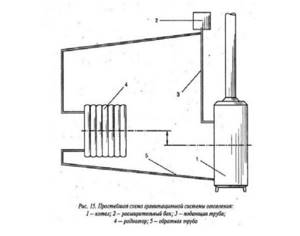
Open type heating systems are of little use for the use of antifreeze.
The home owner does not always know which product was used to fill the heating system last time. In this case, the pipes are completely freed from the previous product, and only then the system is filled.
Distilled water is used to dilute the concentrate. It should not contain calcium and magnesium salts. If you use tap water with a hardness higher than 5 mg-equivalent , there is a possibility of sedimentation.
Attention! The hardness of tap water reaches 20 mg-eql, for this reason it should not be used. To check if the water is suitable, prepare a small amount of solution and see if a precipitate appears.
If it is assumed that antifreeze will be used in the heating system, then you should pay attention to the characteristics of the radiators. Preference is given to models with higher heat transfer rates, internal volume and diameter. The pump power should be 60% higher than that of equipment working with water.
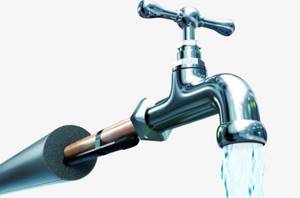
Hard water should not be used to dilute concentrated products.
Automatic air exhaust devices are not designed to work with such coolants. To make it possible to free the system from air, Mayevsky taps are installed on the radiators.
In the system, it is better to use inserts made of materials resistant to glycol media - paronite, Teflon, etc. Threaded connections are laid with flax tow, and a special sealing paste is used as a lubricant. Oil paint is not suitable. The active components of the coolant are good solvents for paintwork materials, as a result of which the system begins to leak.
Antifreeze concentrate is mixed with water in a separate container, and only in this form is the system filled. If you first add coolant and then water, the system may fail. Consequences of ignoring this rule:
- uneven heating of the system, and some radiators may be completely cold due to uneven distribution of the product;
- failure of the circulation pump;
- foaming, which makes it necessary to repeatedly empty and refill the system.
Note! Some solutions are already ready for use; they do not need to be diluted with water. This leads to strong foaming.
If by mistake you add concentrate and water separately, the circulation pump should not be turned on at full power. Take a wait-and-see attitude and periodically bleed air from the system through the radiators. After some time, more or less uniform mixing of water and antifreeze will occur. If the heating system is gravitational with a gravity function, then this process lasts longer.
Video - Disadvantages of using antifreeze in heating systems
Antifreeze should not be used in systems that do not have an accurate temperature controller. When the temperature rises to 70 °C and above, the coolant disintegrates, which is dangerous for the heating system.
After draining the antifreeze and before filling a new portion, the system is washed with clean water or special solutions.
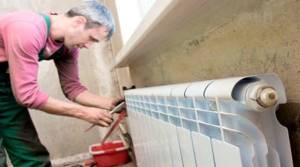
Before refilling antifreeze, it is recommended to flush the heating system
Rules for carrying out work to replace the coolant
For normal coolant circulation inside heating boilers and systems, it is necessary to timely replace antifreeze, which is performed in several steps:
- Stopping the system to reduce its temperature to a safe level;
- Next, the craftsmen drain the circuit - by the color and presence of impurities in the liquid, you can easily determine the degree of internal contamination;
- Before adding new antifreeze liquid, the heat exchangers and system are cleaned. If the contamination is not severe, then the best option is to use a chemical that effectively removes scale and traces of corrosion;
- Then it is washed with clean water, purged with a compressor, then new coolant is poured in and the system is brought into operating mode.
Replacing the coolant restores operating efficiency and allows you to maintain high temperatures with minimal energy consumption (gas, diesel fuel).
Why is it necessary to flush the boiler and system when replacing antifreeze?
During the operation of heating equipment, corrosion occurs in old radiators, radiators, stop valves, and pipes. Also, high temperatures contribute to the formation of deposits and scale directly on the internal surfaces of heat exchangers. There is a need to replace the fluid and clean the system. Our company, along with the chemical method, effectively uses mechanical and hydrodynamic methods. Then it is washed with water and the coolant is replaced with new antifreeze. Now you can use the system in normal mode - the recommended service life is 5 years.
What is used for electrode boilers
In houses where this type of heating equipment is installed, a special type of antifreeze is used. This is due to the fact that alternating current passes through the coolant and ionization of the solution occurs. This puts forward certain requirements for the chemical composition of the product. Appropriate ionization, electrical thermal conductivity, and electrical resistance must be ensured. Usually the boiler manufacturer himself makes recommendations about which product is best to use. And often, depending on the implementation of the recommendation, the warranty on the equipment is maintained.
We recommend an informative article on the topic - Wood-burning boiler for heating a home, where we discussed in detail how to choose a simple and effective boiler.
Antifreeze is an excellent tool for extending the life of a heating system, especially if it is preserved for some time. However, this product must be used correctly. Before use, you should read all operating instructions from the heating equipment manufacturer, as well as the instructions for use of the products. Only in this case will success be guaranteed; radiators and pipes will last for many decades.

